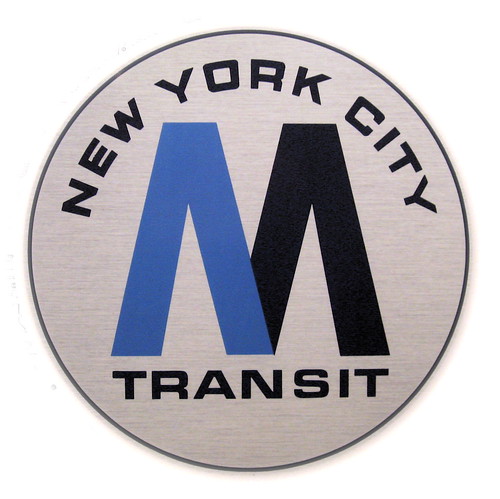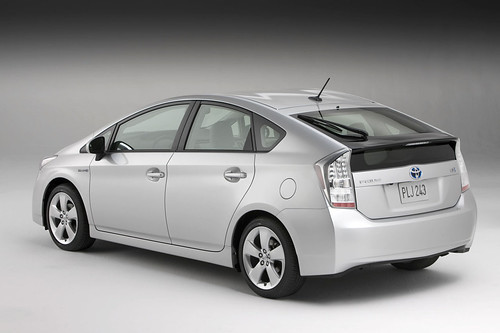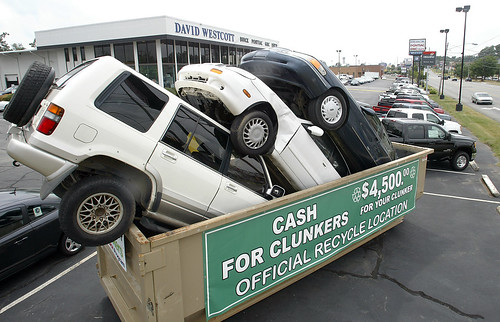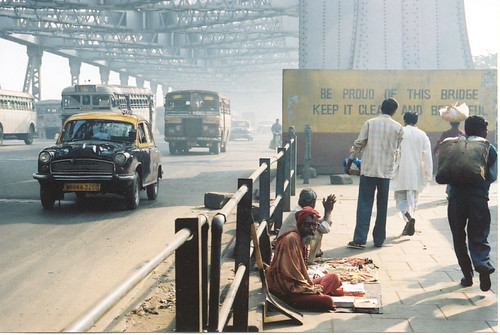(Source: The Guardian, UK)
Ana Portet has had an unusual commute to work. At 7.30am she popped down to Sants railway station in Barcelona. Three hours later she was in a meeting with colleagues from her brewery firm, 315 miles away in Madrid.
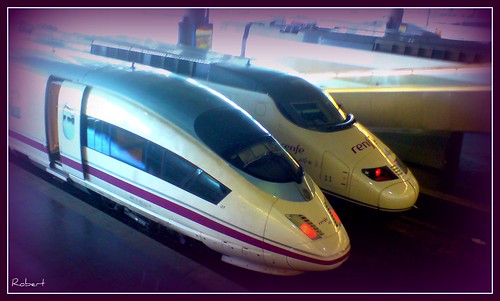
“I’ll be back in Barcelona by half past five,” she said as her early afternoon bullet train flew back along the new high-speed tracks at up to 210mph. “It’s so quick, sometimes you are there before you have even noticed.”
Portet is one of hundreds of thousands of travellers who have migrated from the world’s busiest air shuttle, linking Madrid and Barcelona, to what is now Spain’s most popular train, the high-speed AVE.
The AVE, an intercom announcement has just told us, will leave us in the centre of Barcelona in two hours and 32 minutes. With Madrid’s AVE station a short walk from the Prado museum, the journey is from one city centre to another. What is more, the high-speed train does this in punctual, hassle-free and elegant style.
High-speed trains pulled by aerodynamic engines with noses shaped like a duck-billed platypus are grounding aircraft across Spain. The year-old Barcelona-Madrid line has already taken 46% of the traffic – stealing most of it from fuel-guzzling, carbon-emitting aircraft. As the high-speed rail network spreads a web of tracks across Spain over the next decade, it threatens to relegate domestic air travel to a distant second place.
A high-speed network is not designed overnight. Spain’s AVE story started in the 1980s, when the socialist prime minister Felipe González commissioned a line between Madrid and his home city of Seville. The project was overshadowed by corruption scandals and greeted with a certain amount of scorn. Why was sleepy Seville getting the line and not busy Barcelona? Some saw it as an expensive white elephant and a monument to González’s ego.
The line, however, was a spectacular success. Remote Seville was suddenly two and a half hours from Madrid. Spaniards, used to shabby, lumbering trains that crawled across the countryside following unpredictable timetables, discovered their trains could be stylish and run on time.
Previously the choice on the Madrid-Seville run was between a hot, tiring six-hour coach journey or an aircraft. Seventeen years later, only one traveller out of 10 takes the plane to Seville. The rest go by a train that is 99% punctual. The Seville line proved that high-speed trains could be part of the answer, albeit an expensive part, to some of Spain’s most enduring problems.
By 2020 Spain will have Europe’s largest high-speed network, its 6,000 miles of track outgunning even France’s TGV system. By then 90% of the population will be within 30 miles of a station. New lines have already been opened to Segovia, Valladolid and Malaga in the last 18 months. New links will eventually connect France and Portugal.
The high-speed train network also helps Spain control carbon emissions, with passengers on the Madrid-Barcelona line cutting their own emissions by 83% on the trip.
Click here to read the entire article.
Transportgooru Musings:
Something unusual is happening with the mainstream media these days. There seems to be a renewed interest in pushing the idea of having a high-speed rail network in to the minds of the American public . We have seen two articles on CNN/Fortune have brought too fore how China is pushing ahead with its investment in building a sophisticated, world class HSR network. This spurred a good bit of debate on many popular infrastructure & transportation forums such as the Infrastrucrist. Another one appeared in LA Times, by business writer David Lazarus whose sentiments about the American transportation system was summarized as follows after experiencing the highly systematic & super-sleek Japanese network: “It’s hard to appreciate how truly pitiful our public transportation system is until you spend some time with a system that works.” Many of us know that feeling. Then he gushes about the consistently reliable, affordable and convenient transit systems in Japan. “I rode just about every form of public transit imaginable — bullet trains, express trains, commuter trains, subways, street cars, monorails and buses.” Again, our good friends at Infrastructurist followed-up with a nice debate.
Now we have this Guardian article, that gushes about the glorious Spanish high-speed rail network. I am sure this would stir another round of renewed interest in the minds of us transportation nerds, especially among those who keenly the TransportGooru and Infrastructurist columns on this topic. But do these discussions go beyond the comments section of these portals. I wonder if the Government is even taking note of these anxiety-laden cries that advocate the need for a comparable HSR. As the President and his administration staff reiterate his commitment to keep American workforce competitive in every field, pushing huge loads of money for all sorts of industries (Automobile manufacturing, battery research etc.) , everyone in the Government seems to forget that competitiveness should also extend beyond roads and vehicles. The vast American bureaucracy is slowly pushing ahead with limited funding ($8Billion) and a massive goal (a HSR-network in pockets of nation with targeted connectivity), while other nations like China and Spain are blazing ahead with massive investments in a rail network. Unless we as a nation get serious about investing in alternative transportation options such as rail, we will continue to remain dependent on our expensive oil addiction.
With the Government pushing new thinking such as transit-oriented development, it is probably not too far in the future before urban living becomes “cool” again and the minor discomforts of not having the plush sub-urban life with white picket fences and acre-wide manicured lawns might fade away. The Government facilitated the emergence of the sprawl and the suburban lifestyle with its policy and funding push for interstates. Back in the past were days when railroading was the best alternative for longer distances. Ford and other American automakers created a new way of life with the commercialization of automobile technology, which has now blossomed into a thriving industry. Can the Government enable a similar push for building high speed rail networks around the country?
Before we even get there, let’s first ask: Is there a need for it? Yes, clearly there is a need for it, at least for distances shorter than 400 miles and there is also a desire for it among folks. But the only thing that is lack is the Governmental backing. The paltry $8B will not be enough but it is definitely a good start. It is not always a bad thing to emulate successful strategies, irrespective of where it emulates from. American ingenuity stems from this ability to take ideas irrespective of their origin and tweak to make them suitable for the American landscape. We did this for years by simply importing foreign talent (from nuclear scientists to PhD students) propelled new ideas and thinking to create a huge economy that was atop the world for decades. Why not do the same for building a rail network?
We have the need, we have the people who can get it done. All we need is the willingness to invest and the determination to get it done. As demonstrated in the past, Americans can accomplish great things (from building the interstate system to the invention of the atomic bomb), when the Government stood firm and pushed ahead to finish these mega-projects. Some of these projects not only became a rallying point for nation building (during and after WWII) but they also spawned new economies and industries, spurring job growth and economic development in communities.
For argument sakes, for the time being we can remain content that our nation has a sophisticated air transportation network, with even the tiniest of the towns boasting an airport. In reality, many of our airports are overwhelmed and strained by heavy operational delays and operate with sub-par efficiency, at times also posing a risk to passenger safety. But at the end of the day, we are still going to be an oil-dependent economy, ply our cars and planes with imported for the near future. Of course, there is a lot more to it than just saying and writing it on these websites and newspapers. But that’s where the Government comes in to figure it all out and to make it happen. That’s what the American tax-payers pay for every year before April 15th – to fund and keep a massive bureaucracy working for the to safeguard the interests of its citizens and not budge for the disgruntled political masses.
For what it matters, we are blessed with a dedicated team of professionals who are a part of this massive bureacracy and the USDOT employs thousands of people under its railroad-ing arm, the Federal Railroad Administration (FRA). The agency should be given special powers (agreed that we are not Communist China and it may all have to be worked out within a Democratic framework) to expedite the approval process for the pending HSR proposals. It should also be taken into account that allied industres such as steel manufacturing be reviatlized with incentives for making steel locally. This would be a really good way to resuscitate the long-shuttered steel mills of our nation. Hire a new workforce to build these raillines (as a data nugget, consider what China had been able to do in keeping its workforce busy. The CRCC now employ 110,000 workers on a single line connecting Beijing and Shanghai. If you are running short of professional capacity to build and manage all this new work, employ the new grads coming out of our universities (FYI, the CNN article on Chinese HSR plans offer this data: Last year China Railway Construction Co., the nation’s largest railroad builder, hired 14,000 new university graduates — civil and electrical engineers mostly — from the class of 2008. This year, says Liang Yi, the vice CEO of the CRCC subsidiary working on the Beijing-to-Shanghai high-speed line, the company may hire up to 20,000 new university grads to cope with the company’s intensifying workload. But with the private sector cutting way back on hiring — and university students desperate for work — taking on that many new engineers and managers hasn’t been too difficult) and put them to work on this project of national importance. If we managed to somehow put aside all our political in-fighting and come together to accomplish this in the next 20 years, our future generations may have a better shot at being competitive. We may even see a renewed interest in our nations private-sector players to invest and operate these new railroads (many foreign and local infrastructure firms are now buying rights to build and operate our nation’s ports and toll-roads). Who knows! Someday in the future we may have a sophisticated system if we “get it right”).
It takes a special leader , who can stand tall amidst all the challenges and marshall his troops to get the mission accomplished and our President sure has shown glimpses of such qualities. But as we all know, mere glimpses are not enough. Unless our leadership shows some serious commitment and interest, the possibilities of an average American riding an Ave-like or Shinkansen-like or a TGV-like system will remain elusive. Will the real leader stand up and deliver?



